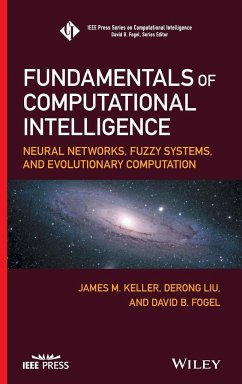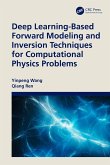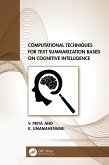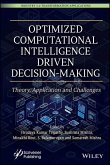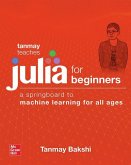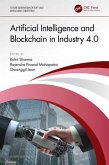James M. Keller, Derong Liu, David B. Fogel (Inc. Natural Selection)
Fundamentals of Computational Intelligence
Neural Networks, Fuzzy Systems, and Evolutionary Computation
James M. Keller, Derong Liu, David B. Fogel (Inc. Natural Selection)
Fundamentals of Computational Intelligence
Neural Networks, Fuzzy Systems, and Evolutionary Computation
- Gebundenes Buch
- Merkliste
- Auf die Merkliste
- Bewerten Bewerten
- Teilen
- Produkt teilen
- Produkterinnerung
- Produkterinnerung
Provides an in-depth and even treatment of the three pillars of computational intelligence and how they relate to one another This book covers the three fundamental topics that form the basis of computational intelligence: neural networks, fuzzy systems, and evolutionary computation.
Andere Kunden interessierten sich auch für
![Deep Learning-Based Forward Modeling and Inversion Techniques for Computational Physics Problems Deep Learning-Based Forward Modeling and Inversion Techniques for Computational Physics Problems]() Yinpeng WangDeep Learning-Based Forward Modeling and Inversion Techniques for Computational Physics Problems104,99 €
Yinpeng WangDeep Learning-Based Forward Modeling and Inversion Techniques for Computational Physics Problems104,99 €![Advancing Computational Intelligence Techniques for Security Systems Design Advancing Computational Intelligence Techniques for Security Systems Design]() Advancing Computational Intelligence Techniques for Security Systems Design156,99 €
Advancing Computational Intelligence Techniques for Security Systems Design156,99 €![Computational Techniques for Text Summarization based on Cognitive Intelligence Computational Techniques for Text Summarization based on Cognitive Intelligence]() V. PriyaComputational Techniques for Text Summarization based on Cognitive Intelligence122,99 €
V. PriyaComputational Techniques for Text Summarization based on Cognitive Intelligence122,99 €![High Performance Loudspeakers High Performance Loudspeakers]() Martin Colloms (UK Colloms Electroacoustics)High Performance Loudspeakers112,99 €
Martin Colloms (UK Colloms Electroacoustics)High Performance Loudspeakers112,99 €![Optimized Computational Intelligence Driven Decision-Making Optimized Computational Intelligence Driven Decision-Making]() Optimized Computational Intelligence Driven Decision-Making209,99 €
Optimized Computational Intelligence Driven Decision-Making209,99 €![Tanmay Teaches Julia for Beginners Tanmay Teaches Julia for Beginners]() Tanmay BakshiTanmay Teaches Julia for Beginners22,99 €
Tanmay BakshiTanmay Teaches Julia for Beginners22,99 €![Artificial Intelligence and Blockchain in Industry 4.0 Artificial Intelligence and Blockchain in Industry 4.0]() Artificial Intelligence and Blockchain in Industry 4.0114,99 €
Artificial Intelligence and Blockchain in Industry 4.0114,99 €-
-
-
Provides an in-depth and even treatment of the three pillars of computational intelligence and how they relate to one another This book covers the three fundamental topics that form the basis of computational intelligence: neural networks, fuzzy systems, and evolutionary computation.
Hinweis: Dieser Artikel kann nur an eine deutsche Lieferadresse ausgeliefert werden.
Hinweis: Dieser Artikel kann nur an eine deutsche Lieferadresse ausgeliefert werden.
Produktdetails
- Produktdetails
- IEEE Press Series on Computational Intelligence
- Verlag: John Wiley & Sons Inc
- Seitenzahl: 378
- Erscheinungstermin: 12. Juli 2016
- Englisch
- Abmessung: 240mm x 161mm x 25mm
- Gewicht: 692g
- ISBN-13: 9781119214342
- ISBN-10: 1119214343
- Artikelnr.: 45194180
- Herstellerkennzeichnung
- Libri GmbH
- Europaallee 1
- 36244 Bad Hersfeld
- 06621 890
- IEEE Press Series on Computational Intelligence
- Verlag: John Wiley & Sons Inc
- Seitenzahl: 378
- Erscheinungstermin: 12. Juli 2016
- Englisch
- Abmessung: 240mm x 161mm x 25mm
- Gewicht: 692g
- ISBN-13: 9781119214342
- ISBN-10: 1119214343
- Artikelnr.: 45194180
- Herstellerkennzeichnung
- Libri GmbH
- Europaallee 1
- 36244 Bad Hersfeld
- 06621 890
James Keller holds the University of Missouri Curators' Professorship in the Electrical and Computer Engineering and Computer Science Departments on the Columbia Campus, and is the R.L. Tatum Professor in the College of Engineering. Dr. Keller is a Life Fellow of the IEEE, a Fellow of the International Fuzzy Systems Association, and a former president of the North American Fuzzy Information Processing Society. Derong Liu is a Professor of Electrical and Computer Engineering at the University of Illinois at Chicago, USA, and a Professor of Automation and Electrical Engineering at the University of Science and Technology Beijing, China. Dr. Liu is a Fellow of the IEEE and a Fellow of the International Neural Network Society. He has published 17 books, including Reinforcement Learning and Approximate Dynamic Programming for Feedback Control (2012, Wiley-IEEE Press). He is the Editor-in-Chief of Artificial Intelligence Review, and he served as the Editor-in-Chief of the IEEE Transactions on Neural Networks and Learning Systems (2010-2015). David Fogel is the President of Natural Selection, Inc., CEO of Natural Selection Financial, Inc., a Fellow of the IEEE, and the series editor for the Wiley-IEEE Press Series on Computational Intelligence. Dr. Fogel has 30 years of experience pioneering contributions in the field of computational intelligence, and is co-inventor of the EffectCheck® sentiment analysis system. He has written several books including Evolutionary Computation: The Fossil Record (1998) and Evolutionary Computation Toward a New Philosophy of Machine Intelligence, 3rd Edition (2005), both published by the Wiley-IEEE Press.
Acknowledgments xi
1. Introduction to Computational Intelligence 1
1.1 Welcome to Computational Intelligence 1
1.2 What Makes This Book Special 1
1.3 What This Book Covers 2
1.4 How to Use This Book 2
1.5 Final Thoughts Before You Get Started 3
PART I NEURAL NETWORKS 5
2. Introduction and Single-Layer Neural Networks 7
2.1 Short History of Neural Networks 9
2.2 Rosenblatt's Neuron 10
2.3 Perceptron Training Algorithm 13
2.4 The Perceptron Convergence Theorem 23
2.5 Computer Experiment Using Perceptrons 25
2.6 Activation Functions 28
Exercises 30
3. Multilayer Neural Networks and Backpropagation 35
3.1 Universal Approximation Theory 35
3.2 The Backpropagation Training Algorithm 37
3.3 Batch Learning and Online Learning 45
3.4 Cross-Validation and Generalization 47
3.5 Computer Experiment Using Backpropagation 53
Exercises 56
4. Radial-Basis Function Networks 61
4.1 Radial-Basis Functions 61
4.2 The Interpolation Problem 62
4.3 Training Algorithms For Radial-Basis Function Networks 64
4.4 Universal Approximation 69
4.5 Kernel Regression 70
Exercises 75
5. Recurrent Neural Networks 77
5.1 The Hopfield Network 77
5.2 The Grossberg Network 81
5.3 Cellular Neural Networks 88
5.4 Neurodynamics and Optimization 91
5.5 Stability Analysis of Recurrent Neural Networks 93
Exercises 99
PART II FUZZY SET THEORY AND FUZZY LOGIC 101
6. Basic Fuzzy Set Theory 103
6.1 Introduction 103
6.2 A Brief History 107
6.3 Fuzzy Membership Functions and Operators 108
6.4 Alpha-Cuts, The Decomposition Theorem, and The Extension Principle 117
6.5 Compensatory Operators 120
6.6 Conclusions 124
Exercises 124
7. Fuzzy Relations and Fuzzy Logic Inference 127
7.1 Introduction 127
7.2 Fuzzy Relations and Propositions 128
7.3 Fuzzy Logic Inference 131
7.4 Fuzzy Logic For Real-Valued Inputs 135
7.5 Where Do The Rules Come From? 138
7.6 Chapter Summary 142
Exercises 143
8. Fuzzy Clustering and Classification 147
8.1 Introduction to Fuzzy Clustering 147
8.2 Fuzzy c-Means 155
8.3 An Extension of The Fuzzy c-Means 167
8.4 Possibilistic c-Means 169
8.5 Fuzzy Classifiers: Fuzzy k-Nearest Neighbors 174
8.6 Chapter Summary 179
Exercises 180
9. Fuzzy Measures and Fuzzy Integrals 183
9.1 Fuzzy Measures 183
9.2 Fuzzy Integrals 188
9.3 Training The Fuzzy Integrals 191
9.4 Summary and Final Thoughts 203
Exercises 203
PART III EVOLUTIONARY COMPUTATION 207
10. Evolutionary Computation 209
10.1 Basic Ideas and Fundamentals 209
10.2 Evolutionary Algorithms: Generate and Test 216
10.3 Representation, Search, and Selection Operators 221
10.4 Major Research and Application Areas 223
10.5 Summary 225
Exercises 225
11. Evolutionary Optimization 227
11.1 Global Numerical Optimization 229
11.2 Combinatorial Optimization 233
11.3 Some Mathematical Considerations 238
11.4 Constraint Handling 255
11.5 Self-Adaptation 258
11.6 Summary 264
Exercises 265
12. Evolutionary Learning and Problem Solving 269
12.1 Evolving Parameters of A Regression Equation 270
12.2 Evolving The Structure and Parameters of Input-Output Systems 274
12.3 Evolving Clusters 292
12.4 Evolutionary Classification Models 298
12.5 Evolutionary Control Systems 307
12.6 Evolutionary Games 314
12.7 Summary 320
Exercises 321
13. Collective Intelligence and Other Extensions of Evolutionary
Computation 323
13.1 Particle Swarm Optimization 323
13.2 Differential Evolution 326
13.3 Ant Colony Optimization 329
13.4 Evolvable Hardware 331
13.5 Interactive Evolutionary Computation 333
13.6 Multicriteria Evolutionary Optimization 335
13.7 Summary 340
Exercises 340
References 343
Index 361
1. Introduction to Computational Intelligence 1
1.1 Welcome to Computational Intelligence 1
1.2 What Makes This Book Special 1
1.3 What This Book Covers 2
1.4 How to Use This Book 2
1.5 Final Thoughts Before You Get Started 3
PART I NEURAL NETWORKS 5
2. Introduction and Single-Layer Neural Networks 7
2.1 Short History of Neural Networks 9
2.2 Rosenblatt's Neuron 10
2.3 Perceptron Training Algorithm 13
2.4 The Perceptron Convergence Theorem 23
2.5 Computer Experiment Using Perceptrons 25
2.6 Activation Functions 28
Exercises 30
3. Multilayer Neural Networks and Backpropagation 35
3.1 Universal Approximation Theory 35
3.2 The Backpropagation Training Algorithm 37
3.3 Batch Learning and Online Learning 45
3.4 Cross-Validation and Generalization 47
3.5 Computer Experiment Using Backpropagation 53
Exercises 56
4. Radial-Basis Function Networks 61
4.1 Radial-Basis Functions 61
4.2 The Interpolation Problem 62
4.3 Training Algorithms For Radial-Basis Function Networks 64
4.4 Universal Approximation 69
4.5 Kernel Regression 70
Exercises 75
5. Recurrent Neural Networks 77
5.1 The Hopfield Network 77
5.2 The Grossberg Network 81
5.3 Cellular Neural Networks 88
5.4 Neurodynamics and Optimization 91
5.5 Stability Analysis of Recurrent Neural Networks 93
Exercises 99
PART II FUZZY SET THEORY AND FUZZY LOGIC 101
6. Basic Fuzzy Set Theory 103
6.1 Introduction 103
6.2 A Brief History 107
6.3 Fuzzy Membership Functions and Operators 108
6.4 Alpha-Cuts, The Decomposition Theorem, and The Extension Principle 117
6.5 Compensatory Operators 120
6.6 Conclusions 124
Exercises 124
7. Fuzzy Relations and Fuzzy Logic Inference 127
7.1 Introduction 127
7.2 Fuzzy Relations and Propositions 128
7.3 Fuzzy Logic Inference 131
7.4 Fuzzy Logic For Real-Valued Inputs 135
7.5 Where Do The Rules Come From? 138
7.6 Chapter Summary 142
Exercises 143
8. Fuzzy Clustering and Classification 147
8.1 Introduction to Fuzzy Clustering 147
8.2 Fuzzy c-Means 155
8.3 An Extension of The Fuzzy c-Means 167
8.4 Possibilistic c-Means 169
8.5 Fuzzy Classifiers: Fuzzy k-Nearest Neighbors 174
8.6 Chapter Summary 179
Exercises 180
9. Fuzzy Measures and Fuzzy Integrals 183
9.1 Fuzzy Measures 183
9.2 Fuzzy Integrals 188
9.3 Training The Fuzzy Integrals 191
9.4 Summary and Final Thoughts 203
Exercises 203
PART III EVOLUTIONARY COMPUTATION 207
10. Evolutionary Computation 209
10.1 Basic Ideas and Fundamentals 209
10.2 Evolutionary Algorithms: Generate and Test 216
10.3 Representation, Search, and Selection Operators 221
10.4 Major Research and Application Areas 223
10.5 Summary 225
Exercises 225
11. Evolutionary Optimization 227
11.1 Global Numerical Optimization 229
11.2 Combinatorial Optimization 233
11.3 Some Mathematical Considerations 238
11.4 Constraint Handling 255
11.5 Self-Adaptation 258
11.6 Summary 264
Exercises 265
12. Evolutionary Learning and Problem Solving 269
12.1 Evolving Parameters of A Regression Equation 270
12.2 Evolving The Structure and Parameters of Input-Output Systems 274
12.3 Evolving Clusters 292
12.4 Evolutionary Classification Models 298
12.5 Evolutionary Control Systems 307
12.6 Evolutionary Games 314
12.7 Summary 320
Exercises 321
13. Collective Intelligence and Other Extensions of Evolutionary
Computation 323
13.1 Particle Swarm Optimization 323
13.2 Differential Evolution 326
13.3 Ant Colony Optimization 329
13.4 Evolvable Hardware 331
13.5 Interactive Evolutionary Computation 333
13.6 Multicriteria Evolutionary Optimization 335
13.7 Summary 340
Exercises 340
References 343
Index 361
Acknowledgments xi
1. Introduction to Computational Intelligence 1
1.1 Welcome to Computational Intelligence 1
1.2 What Makes This Book Special 1
1.3 What This Book Covers 2
1.4 How to Use This Book 2
1.5 Final Thoughts Before You Get Started 3
PART I NEURAL NETWORKS 5
2. Introduction and Single-Layer Neural Networks 7
2.1 Short History of Neural Networks 9
2.2 Rosenblatt's Neuron 10
2.3 Perceptron Training Algorithm 13
2.4 The Perceptron Convergence Theorem 23
2.5 Computer Experiment Using Perceptrons 25
2.6 Activation Functions 28
Exercises 30
3. Multilayer Neural Networks and Backpropagation 35
3.1 Universal Approximation Theory 35
3.2 The Backpropagation Training Algorithm 37
3.3 Batch Learning and Online Learning 45
3.4 Cross-Validation and Generalization 47
3.5 Computer Experiment Using Backpropagation 53
Exercises 56
4. Radial-Basis Function Networks 61
4.1 Radial-Basis Functions 61
4.2 The Interpolation Problem 62
4.3 Training Algorithms For Radial-Basis Function Networks 64
4.4 Universal Approximation 69
4.5 Kernel Regression 70
Exercises 75
5. Recurrent Neural Networks 77
5.1 The Hopfield Network 77
5.2 The Grossberg Network 81
5.3 Cellular Neural Networks 88
5.4 Neurodynamics and Optimization 91
5.5 Stability Analysis of Recurrent Neural Networks 93
Exercises 99
PART II FUZZY SET THEORY AND FUZZY LOGIC 101
6. Basic Fuzzy Set Theory 103
6.1 Introduction 103
6.2 A Brief History 107
6.3 Fuzzy Membership Functions and Operators 108
6.4 Alpha-Cuts, The Decomposition Theorem, and The Extension Principle 117
6.5 Compensatory Operators 120
6.6 Conclusions 124
Exercises 124
7. Fuzzy Relations and Fuzzy Logic Inference 127
7.1 Introduction 127
7.2 Fuzzy Relations and Propositions 128
7.3 Fuzzy Logic Inference 131
7.4 Fuzzy Logic For Real-Valued Inputs 135
7.5 Where Do The Rules Come From? 138
7.6 Chapter Summary 142
Exercises 143
8. Fuzzy Clustering and Classification 147
8.1 Introduction to Fuzzy Clustering 147
8.2 Fuzzy c-Means 155
8.3 An Extension of The Fuzzy c-Means 167
8.4 Possibilistic c-Means 169
8.5 Fuzzy Classifiers: Fuzzy k-Nearest Neighbors 174
8.6 Chapter Summary 179
Exercises 180
9. Fuzzy Measures and Fuzzy Integrals 183
9.1 Fuzzy Measures 183
9.2 Fuzzy Integrals 188
9.3 Training The Fuzzy Integrals 191
9.4 Summary and Final Thoughts 203
Exercises 203
PART III EVOLUTIONARY COMPUTATION 207
10. Evolutionary Computation 209
10.1 Basic Ideas and Fundamentals 209
10.2 Evolutionary Algorithms: Generate and Test 216
10.3 Representation, Search, and Selection Operators 221
10.4 Major Research and Application Areas 223
10.5 Summary 225
Exercises 225
11. Evolutionary Optimization 227
11.1 Global Numerical Optimization 229
11.2 Combinatorial Optimization 233
11.3 Some Mathematical Considerations 238
11.4 Constraint Handling 255
11.5 Self-Adaptation 258
11.6 Summary 264
Exercises 265
12. Evolutionary Learning and Problem Solving 269
12.1 Evolving Parameters of A Regression Equation 270
12.2 Evolving The Structure and Parameters of Input-Output Systems 274
12.3 Evolving Clusters 292
12.4 Evolutionary Classification Models 298
12.5 Evolutionary Control Systems 307
12.6 Evolutionary Games 314
12.7 Summary 320
Exercises 321
13. Collective Intelligence and Other Extensions of Evolutionary
Computation 323
13.1 Particle Swarm Optimization 323
13.2 Differential Evolution 326
13.3 Ant Colony Optimization 329
13.4 Evolvable Hardware 331
13.5 Interactive Evolutionary Computation 333
13.6 Multicriteria Evolutionary Optimization 335
13.7 Summary 340
Exercises 340
References 343
Index 361
1. Introduction to Computational Intelligence 1
1.1 Welcome to Computational Intelligence 1
1.2 What Makes This Book Special 1
1.3 What This Book Covers 2
1.4 How to Use This Book 2
1.5 Final Thoughts Before You Get Started 3
PART I NEURAL NETWORKS 5
2. Introduction and Single-Layer Neural Networks 7
2.1 Short History of Neural Networks 9
2.2 Rosenblatt's Neuron 10
2.3 Perceptron Training Algorithm 13
2.4 The Perceptron Convergence Theorem 23
2.5 Computer Experiment Using Perceptrons 25
2.6 Activation Functions 28
Exercises 30
3. Multilayer Neural Networks and Backpropagation 35
3.1 Universal Approximation Theory 35
3.2 The Backpropagation Training Algorithm 37
3.3 Batch Learning and Online Learning 45
3.4 Cross-Validation and Generalization 47
3.5 Computer Experiment Using Backpropagation 53
Exercises 56
4. Radial-Basis Function Networks 61
4.1 Radial-Basis Functions 61
4.2 The Interpolation Problem 62
4.3 Training Algorithms For Radial-Basis Function Networks 64
4.4 Universal Approximation 69
4.5 Kernel Regression 70
Exercises 75
5. Recurrent Neural Networks 77
5.1 The Hopfield Network 77
5.2 The Grossberg Network 81
5.3 Cellular Neural Networks 88
5.4 Neurodynamics and Optimization 91
5.5 Stability Analysis of Recurrent Neural Networks 93
Exercises 99
PART II FUZZY SET THEORY AND FUZZY LOGIC 101
6. Basic Fuzzy Set Theory 103
6.1 Introduction 103
6.2 A Brief History 107
6.3 Fuzzy Membership Functions and Operators 108
6.4 Alpha-Cuts, The Decomposition Theorem, and The Extension Principle 117
6.5 Compensatory Operators 120
6.6 Conclusions 124
Exercises 124
7. Fuzzy Relations and Fuzzy Logic Inference 127
7.1 Introduction 127
7.2 Fuzzy Relations and Propositions 128
7.3 Fuzzy Logic Inference 131
7.4 Fuzzy Logic For Real-Valued Inputs 135
7.5 Where Do The Rules Come From? 138
7.6 Chapter Summary 142
Exercises 143
8. Fuzzy Clustering and Classification 147
8.1 Introduction to Fuzzy Clustering 147
8.2 Fuzzy c-Means 155
8.3 An Extension of The Fuzzy c-Means 167
8.4 Possibilistic c-Means 169
8.5 Fuzzy Classifiers: Fuzzy k-Nearest Neighbors 174
8.6 Chapter Summary 179
Exercises 180
9. Fuzzy Measures and Fuzzy Integrals 183
9.1 Fuzzy Measures 183
9.2 Fuzzy Integrals 188
9.3 Training The Fuzzy Integrals 191
9.4 Summary and Final Thoughts 203
Exercises 203
PART III EVOLUTIONARY COMPUTATION 207
10. Evolutionary Computation 209
10.1 Basic Ideas and Fundamentals 209
10.2 Evolutionary Algorithms: Generate and Test 216
10.3 Representation, Search, and Selection Operators 221
10.4 Major Research and Application Areas 223
10.5 Summary 225
Exercises 225
11. Evolutionary Optimization 227
11.1 Global Numerical Optimization 229
11.2 Combinatorial Optimization 233
11.3 Some Mathematical Considerations 238
11.4 Constraint Handling 255
11.5 Self-Adaptation 258
11.6 Summary 264
Exercises 265
12. Evolutionary Learning and Problem Solving 269
12.1 Evolving Parameters of A Regression Equation 270
12.2 Evolving The Structure and Parameters of Input-Output Systems 274
12.3 Evolving Clusters 292
12.4 Evolutionary Classification Models 298
12.5 Evolutionary Control Systems 307
12.6 Evolutionary Games 314
12.7 Summary 320
Exercises 321
13. Collective Intelligence and Other Extensions of Evolutionary
Computation 323
13.1 Particle Swarm Optimization 323
13.2 Differential Evolution 326
13.3 Ant Colony Optimization 329
13.4 Evolvable Hardware 331
13.5 Interactive Evolutionary Computation 333
13.6 Multicriteria Evolutionary Optimization 335
13.7 Summary 340
Exercises 340
References 343
Index 361

